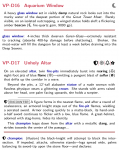Wow. That's kind of a big deal really. VTTs will probably reshape the hobby. In many ways, having proper computer-aided DMing was a pipe-dream...but now?
Can you post a "modern map"?
Still, for old-school paper-published material...
You can do more complex things with a VTT that would totally not be worth the effort in a pencil and paper game. Anything that requires tracking by round, or complex math. If they build it in, like dynamic lighting, it doesn't require much effort to use either.
On the other hand, if you are like me and try to make it do everything but make you a sandwich, it can be a bit of a time hog out of game, but the game itself can run like a dream. The modified framework I use will let you make several attacks at a time and automatically determines if attacks hit, calculates damage, deducts the damage from enemy hit points, tells me if they are bloodied or dying, tracks any conditions that are applied, and gives me various reminders of the sort of things I am likely to forget. Gear is tracked on the token, as is encumbrance. And of course it rolls and tracks initiative for every creature in a battle. Dynamic lighting means there is no confusion about what a creature can see. It will calculate how far the creatures can move in a round, and will slow them down if they have to cross difficult terrain.
I find that running the combat and movement is so much easier that I can devote a lot more mental energy to roleplaying the NPCs. So leaders are shouting orders in combat, which PCs might be able to decipher, and I never lose track of NPC motivations.
As for the map, of course now that I'm on the spot I have had a hell of a time finding examples online. It also looks like the new stuff may be cleaned up, so maybe other people were having the same problem. Anyway,
here is an example; look at the set dressing in room 4 or the pile of treasure in room 9/10 for the sort of stock details that can cause confusion.
One my my pet peeves is the representation of trees in outdoor maps. Cartographers always draw in the canopy. No matter how many times I remind my players, they always seem to forget that the canopy is above their heads, and provides no cover or concealment against enemies on the forest floor. When I draw forest maps, I draw the trunk and the
shadow of the canopy. Then I can add undergrowth only if I want it.


